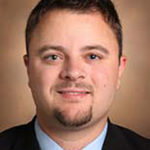Junior Faculty Teaching Fellow Spotlight:Jason Valentine
Each month, the CFT Newsletter highlights the work of our Junior Faculty Teaching Fellows. This month, Jason Valentine, Assistant Professor, Mechanical Engineering, talks about his teaching philosophy and interests:
My overarching goal in teaching heat transfer is for students to be able to identify the application of heat transfer in various engineering systems and quantitatively analyze and design engineering solutions. This course is quite heavy on mathematics and the biggest challenge in teaching it is making sure that the students truly grasp the physical meaning of equations. With a physical intuition, students can understand how the foundational equations / physics described in lecture can be extended to understand more complicated heat transfer scenarios. I also put a large emphasis on illustrating how heat transfer concepts can be applied to everyday situations, making sure to use examples that the students find relevant.
The culmination of the course is an open ended design problem in which I challenge the students to go above and beyond current technology in solving engineering problems, such as scavenging waste energy from an engine. This gives students an opportunity to think creatively while also teaching them how to integrate all of the concepts learned in the course. This year at CFT, I hope to learn how to better engage students in lecture by integrating hands-on demonstrations and cooperative learning activities.

” I challenge the students to go above and beyond current technology in solving engineering problems, such as scavenging waste energy from an engine. This gives students an opportunity to think creatively while also teaching them how to integrate all of the concepts learned in the course.”
In my laboratory, we investigate the optical properties of nanostructured materials with the goal of realizing novel optical phenomena and devices. The use of nanostructuring affords us the ability to engineer the optical properties of materials such as the index of refraction and absorption coefficient, realizing optical properties which are absent in naturally occurring materials. In my heat transfer course, I outline these concepts in terms of radiative heat transfer, giving the students a glimpse into the nanoscale world and active research areas. These concepts also form the basis for a graduate course that I teach on micro and nanoscale photonics wherein I show how fundamental material and optics concepts are being utilized in active research areas to realize new types of optical materials.

Leave a Response